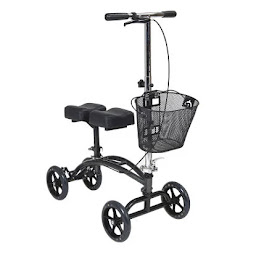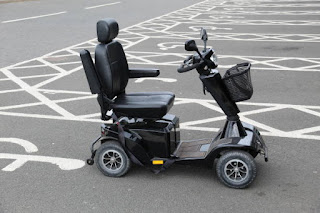How to Choose the Best Knee Scooter
If you or a loved one has a lower leg injury, you may want to consider a knee scooter, also known as a one leg scooter, knee walker scooter, knee roller, knee wheelchair, or rolling knee walker.
This form of mobility device is an excellent substitute for crutches. This article will teach you everything you need to know about knee scooters, covering what they are, the different varieties, what to look for, and what to avoid.What is a Knee Scooter?
A knee scooter is a type of mobility device that is meant to take the weight off one leg. These mobility aids usually feature three or four wheels, a cushioned knee platform, and brake-equipped handlebars.
Medical leg scooters resemble typical four-wheel scooters in appearance. However, instead of a seat, they include a knee pad on which to rest your damaged leg. They usually include handlebars, brakes, and a built-in knee scooter basket for personal goods.
Knee scooters are seen as a viable alternative to crutches. They're used to keep people mobile as they heal from lower leg surgeries or injuries like:
● Fractures
● Diabetes-related sores and ulcers
● Achilles tendon rupture
● Ankle sprains
Knee walkers help disabled people keep weight off their damaged legs while staying mobile and independent.
Types of Knee Scooters:
While the majority of knee scooters are meant to achieve the same thing they are tailored to different lifestyles and environments. We've highlighted a few different varieties of knee scooters below.
Three wheels: While less common, three-wheel knee scooters can provide a more nimble mode of transportation. They normally have two back wheels and one front wheel. A smaller turn radius is possible due to the single front wheel. They are generally more compact since they have one less wheel. Please keep in mind that three-wheel scooters are slightly less stable and more prone to tipping/falling.
Four wheels : Models with four wheels are the most common and widely available form of knee scooter. These have two front wheels and two back wheels. They cannot turn as sharply as three-wheel scooters, but they are more stable and much less likely to tip/fall.
All-terrain: All-terrain knee scooters have bigger and wider wheels that allow riders to go across rough terrain like grass, mud, or pebbles. If you have an active lifestyle, an all-terrain knee walker with bigger wheels may be ideal.
Bariatric: To handle increased weight capacities, bariatric knee scooters are built from very robust materials. These heavy-duty knee scooters might also have a bigger support surface, such as broader handles and a larger knee pad. Before purchasing any knee scooter, ensure the weight capacity fulfills your requirements.
Signs You Need a Knee Scooter
Before obtaining any mobility assistance, you must first determine if you require it. It's vital to remember that knee walkers are only intended to provide brief mobility assistance. They are not intended to be a long-term alternative like wheelchairs, walkers, and canes. Below are some important qualities that may make a knee scooter a good option for you:
● Weak or unbalanced enough to require crutches
● Inadequate upper-body strength for crutches
● Problems with balance
● People broken foot, sprained ankles, or diabetic wounds and ulcers.
Conclusion
Knee scooters are ideal for those who have either poor gross motor skills, poor balance, are prone to falls, have lower leg problems, or are on the move for most of the day. Standard crutches can be difficult to use and can cause upper body fatigue. Knee scooters are a great way to keep moving without straining your upper body. Get premium knee scooters or knee walker in Canada from the experts at Scootaround. They also provide electric wheelchairs and mobility scooters in Canada.


.jpg)

Comments
Post a Comment